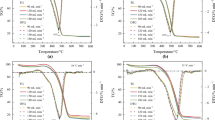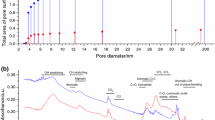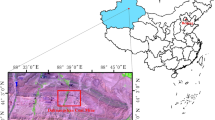Abstract
Underground coal fires (UCFs) cause remarkable loss of energy resources and significant environmental pollution. Due to the limited capacity of oxygen transport, the inception and development of UCFs represent a very unique mode of coal–oxygen reactions. Therefore, a high-volatile flammable coal sample is thermally analyzed with the combined TGA–DSC approach under four oxygen concentrations (21%, 15%, 9% and 3%) and three heating rates (1 °C min−1, 2 °C min−1 and 5 °C min−1). It is found that the oxygen concentration does not significantly influence the early (low-temperature) stage of coal–oxygen reactions. With the decrease in oxygen concentration, the intensity of the exothermic reactions is reduced and the duration of reactions is extended. Based on the experimental results, the apparent activation energy is calculated. The variation of the apparent activation energy reflects the different reaction stages: volatiles burning and char oxidation, which is verified by the TGA–DSC results. Under the extreme condition of 3% oxygen concentration, a very distinct macroscopic thermochemical behavior is observed, and the limited oxygen supply controls the reaction rate throughout the entire process, which qualitatively explains the persistency of the burning phenomena in most UCFs.
Similar content being viewed by others
References
Kuenzer C, Zhang J, Tetzlaff A, van Dijk P, Voigt S, Mehl H, et al. Uncontrolled coal fires and their environmental impacts: Investigating two arid mining regions in north-central China. Appl Geogr. 2007;27:42–62.
Stracher GB, Taylor TP. Coal fires burning out of control around the world: thermodynamic recipe for environmental catastrophe. Int J Coal Geol. 2004;59:7–17.
Melody SM, Johnston FH. Coal mine fires and human health: What do we know? Int J Coal Geol. 2015;152:1–14.
Zhang Y, Li Y, Huang Y, Li S, Wang W. Characteristics of mass, heat and gaseous products during coal spontaneous combustion using TG/DSC–FTIR technology. J Therm Anal Calorim. 2017;131:2963–74.
Tang Y, Wang H. Experimental investigation on microstructure evolution and spontaneous combustion properties of secondary oxidation of lignite. Process Saf Environ. 2019;124:143–50.
Carras JN, Young BC. Self-heating of coal and related materials: models, application and test methods. Prog Energ Combust. 1994;20:1–15.
Wang H, Dlugogorski BZ, Kennedy EM. Coal oxidation at low temperatures: oxygen consumption, oxidation products, reaction mechanism and kinetic modelling. Prog Energ Combust. 2003;29:487–513.
Green U, Aizenshtat Z, Metzger L, Cohen H. Field and Laboratory Simulation Study of Hot Spots in Stockpiled Bituminous Coal. Energ Fuel. 2012;26:7230–5.
Zhang Y, Wu J, Chang L, Wang J, Xue S. Kinetic and thermodynamic studies on the mechanism of low-temperature oxidation of coal: A case study of Shendong coal (China). Int J Coal Geol. 2013;120:41–9.
Wang H, Dlugogorski BZ, Kennedy EM. Examination of CO2, CO, and H2O Formation during low-temperature oxidation of a Bituminous Coal. Energ Fuel. 2002;16:586–92.
Dong X, Wen Z, Wang F, Meng Y. Law of gas production during coal heating oxidation. Int J Min Sci Techno. 2019;29:617–20.
Yang Y, Li Z, Hou S, Gu F, Gao S, Tang Y. The shortest period of coal spontaneous combustion on the basis of oxidative heat release intensity. Int J Min Sci Techno. 2014;24:99–103.
Jayaraman K, Gökalp I. Thermal characterization, gasification and kinetic studies of different sized Indian coal and char particles. Int J Eng Sci. 2014;6:31–40.
Song Z, Huang X, Luo M, Gong J, Pan X. Experimental study on the diffusion–kinetics interaction in heterogeneous reaction of coal. J Therm Anal Calorim. 2017;129:1625–37.
Wang D, Xin H, Qi X, Dou G, Qi G, Ma L. Reaction pathway of coal oxidation at low temperatures: a model of cyclic chain reactions and kinetic characteristics. Combust Flame. 2016;163:447–60.
Arisoy A, Beamish B. Reaction kinetics of coal oxidation at low temperatures. Fuel. 2015;159:412–7.
Kim CJ, Sohn CH. A novel method to suppress spontaneous ignition of coal stockpiles in a coal storage yard. Fuel Process Technol. 2012;100:73–83.
Rosema A, Guan H, Veld H. Simulation of spontaneous combustion, to study the causes of coal fires in the Rujigou Basin. Fuel. 2001;80:7–16.
Song Z, Wu D, Jiang J, Pan X. Thermo-solutal buoyancy driven air flow through thermally decomposed thin porous media in a U-shaped channel: Towards understanding persistent underground coal fires. Appl Therm Eng. 2019;159:113948.
Song Z, Huang X, Jiang J, Pan X. A laboratory approach to CO2 and CO emission factors from underground coal fires. Int J Coal Geol. 2020;219:103382.
Yang J, Liu N, Chen H, Gao W, Tu R. Effects of atmospheric oxygen on horizontal peat smoldering fires: Experimental and numerical study. Proc Combust Inst. 2018;37:4063–71.
Qi G, Wang D, Zheng K, Tang Y, Lu X. Smoldering combustion of coal under forced air flow: experimental investigation. J Fire Sci. 2016;34:267–88.
Song Z, Kuenzer C. Coal fires in China over the last decade: A comprehensive review. Int J Coal Geol. 2014;133:72–99.
Kök M. Recent developments in the application of thermal analysis techniques in fossil fuels. J Therm Anal Calorim. 2008;91:763–73.
Russell N, Beeley T, Man CK, Gibbins J, Williamson J. Development of TG measurements of intrinsic char combustion reactivity for industrial and research purposes. Fuel Process Technol. 1998;57:113–30.
Li J, Fu P, Mao Y, Saini V, Sokol E. A Parametric Study on the Inception and Evolution of Underground Coal Fires Based on a Lab-Scale Experimental Setup. Fire Technol. 2019;56:1039–57.
Qi X, Li Q, Zhang H, Xin H. Thermodynamic characteristics of coal reaction under low oxygen concentration conditions. J Energy Inst. 2017;90:544–55.
Li Z, Zhang Y, Jing X, Zhang Y, Chang L. Insight into the intrinsic reaction of brown coal oxidation at low temperature: Differential scanning calorimetry study. Fuel Process Technol. 2016;147:64–70.
Deng J, Li Q, Xiao Y, Wen H. The effect of oxygen concentration on the non-isothermal combustion of coal. Thermochim Acta. 2017;653:106–15.
Qi G, Wang D, Zheng K, Xu J, Qi X, Zhong X. Kinetics characteristics of coal low-temperature oxidation in oxygen-depleted air. J Loss Prevent Proc. 2015;35:224–31.
Li Q, Xiao Y, Wang C, Deng J, Shu C. Thermokinetic characteristics of coal spontaneous combustion based on thermogravimetric analysis. Fuel. 2019;250:235–44.
Naktiyok J. Determination of the self-heating temperature of coal by means of TGA analysis. Energ Fuel. 2018;32:2299–305.
Li X, Li C, Zhang H, Li W. Analysis on the status and problems of lignite application in China. Appl Chem Ind. 2020;49:1226–30 ([in Chinese]).
Xin H, Wang H, Kang W, Di C, Qi X, Zhong X, et al. The reburning thermal characteristics of residual structure of lignite pyrolysis. Fuel. 2020;259:116226.
Wang C, Zhang X, Liu Y, Che D. Pyrolysis and combustion characteristics of coals in oxy-fuel combustion. Appl Energ. 2012;97:264–73.
Liu Y, Cao X, Duan X, Wang Y, Che D. Thermal analysis on combustion characteristics of predried dyeing sludge. Appl Therm Eng. 2018;140:158–65.
Vyazovkin S, Burnham AK, Criado JM, Pérez-Maqueda LA, Popescu C, Sbirrazzuoli N. ICTAC Kinetics Committee recommendations for performing kinetic computations on thermal analysis data. Thermochim Acta. 2011;520:1–1.
Acknowledgements
The authors gratefully acknowledge the financial support provided by the National Natural Science Foundation of China (Grant No. 51850410504) and Open Projects of State Key Laboratory of Coal Resources and Safe Mining of CUMT (Grant No. 14KF01).
Author information
Authors and Affiliations
Corresponding author
Additional information
Publisher's Note
Springer Nature remains neutral with regard to jurisdictional claims in published maps and institutional affiliations.
Rights and permissions
About this article
Cite this article
Li, J., Yang, Y., Li, J. et al. A TGA–DSC-based study on macroscopic behaviors of coal–oxygen reactions in context of underground coal fires. J Therm Anal Calorim 147, 3185–3194 (2022). https://doi.org/10.1007/s10973-021-10671-z
Received:
Accepted:
Published:
Issue Date:
DOI: https://doi.org/10.1007/s10973-021-10671-z












